Gardens with lots of shade, acidic soil types, or damp spots can be a challenge to garden in. However, there is one group of plants that tends to thrive in these adverse conditions: ferns! As long as you provide ferns with the proper balance of light, water, and nutrients, these plants are quite easy to keep, and their lush leaves and elegant forms are welcome additions to formal gardens, cottage garden displays, and container planters too!
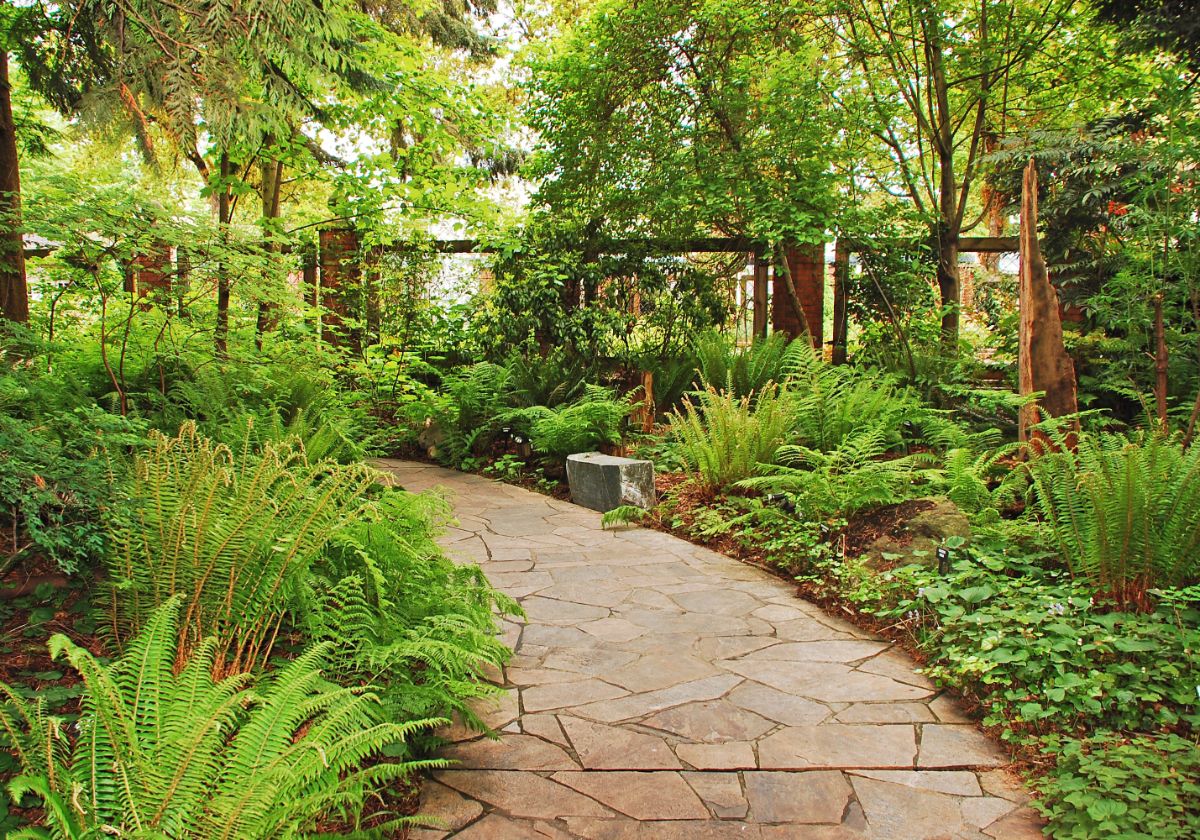
If you’re on the hunt for the best ferns to grow outdoors, you’re in luck. In the list below, you’ll find an assortment of ferns that can thrive in both sun and shade, as well as some cold hardy fern types that can grow in areas as cool as Zone 2. No matter your garden type or style, you’re sure to find the perfect fern for you in this guide!
Jump to:
- 15 popular ferns to grow outdoors
- 1. Ostrich fern (Matteuccia struthiopteris)
- 2. Cinnamon fern (Osmundastrum cinnamomeum)
- 3. Lady fern (Athyrium filix-femina)
- 4. Sensitive fern (Onoclea sensibilis)
- 5. Boston fern (Nephrolepis exaltata)
- 6. Australian tree fern (Sphaeropteris cooperi)
- 7. Holly fern (Cyrtomium falcatum)
- 8. Autumn fern (Dryopteris erythrosora)
- 9. Maidenhair fern (Adiantum pedatum)
- 10. Christmas fern (Polystichum acrostichoides)
- 11. Japanese painted fern (Athyrium niponicum)
- 12. Royal fern (Osmunda regalis)
- 13. Staghorn fern (Platycerium spp.)
- 14. Sweet fern (Comptonia peregrina)
- 15. Asparagus fern (Asparagus setaceus)
- Frequently asked questions
- Summary
15 popular ferns to grow outdoors
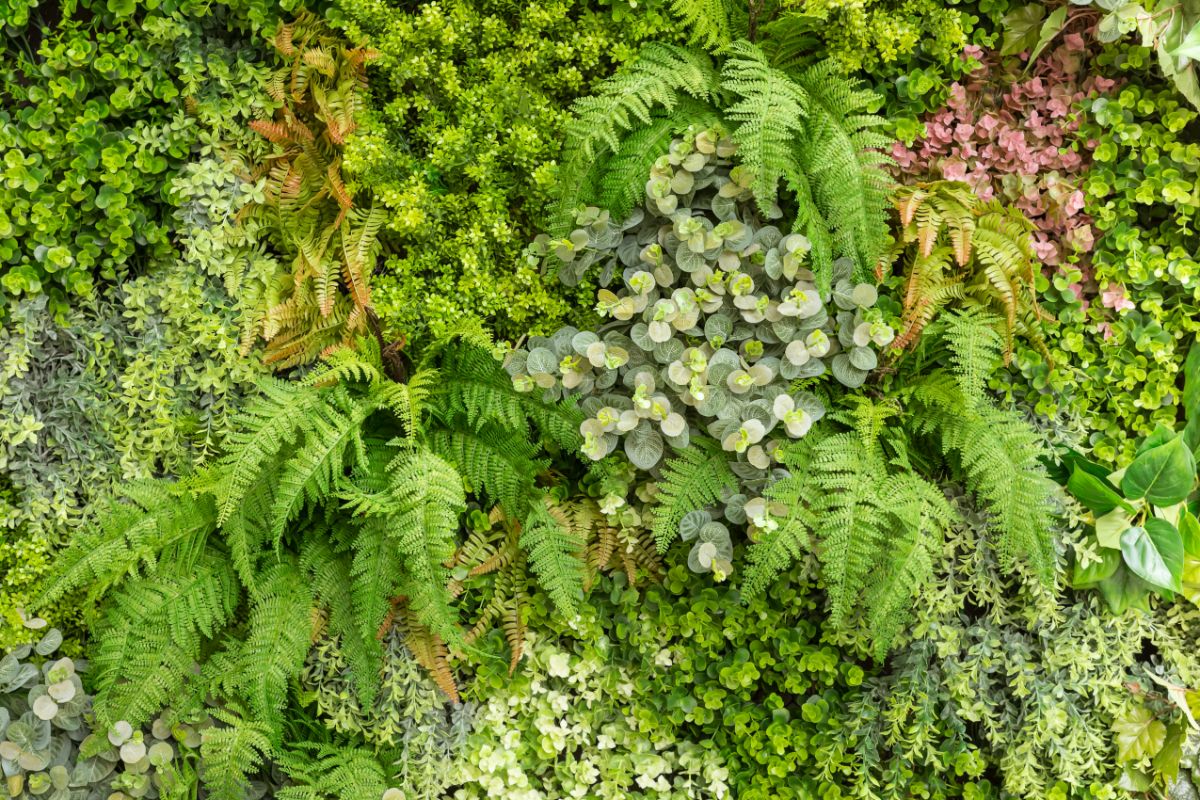
Ferns range in size from small foliage plants that can be kept in pots to massive trees that can stretch over 50’ tall. Getting clear on how you want to use ferns in your landscape will help you choose the right ferns for your garden space and landscape style.
1. Ostrich fern (Matteuccia struthiopteris)
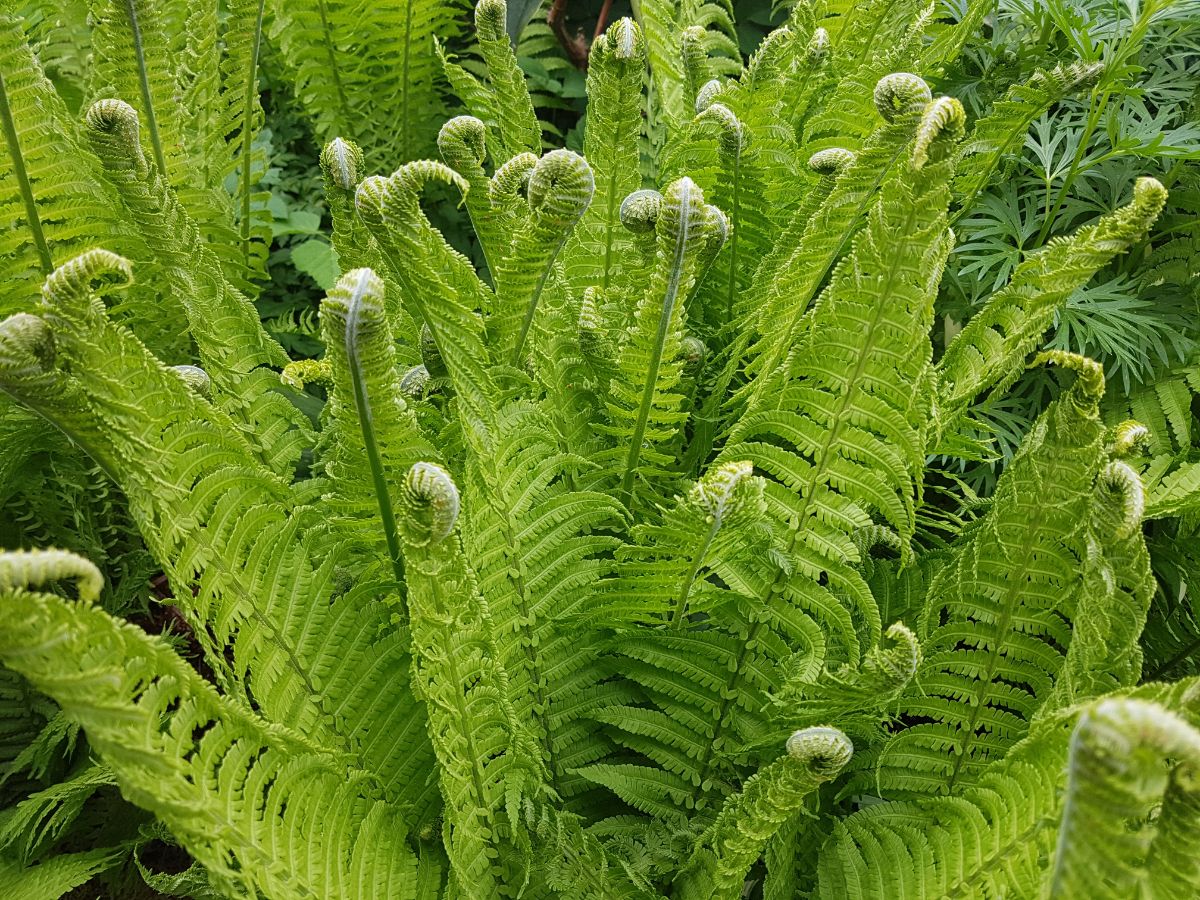
| Plant name: | Ostrich fern |
| Light requirements: | Shade to part shade |
| Water requirements: | High |
| Growing zone: | Zones 3 to 7 |
Native to North America, Europe, and Asia, ostrich ferns are stately specimen plants that are particularly well suited for growing in moist and shaded areas. Planted en masse along the margins of woodlands or in rain gardens, ostrich ferns add a lovely pop of color and make a solid backdrop for low-growing, shade-loving plants like trillium, astilbe, and bloodroot. Ostrich ferns can also sometimes be grown in containers, although they will do best in inground beds.
When mature, ostrich ferns grow up to 6’ tall, and they can spread from 5 to 8’ wide. As deciduous plants, ostrich ferns drop their leaves relatively early in autumn, but they are very cold hardy, and they can thrive in zones 3 and up. And while ostrich ferns have lots of ornamental appeal, they are mostly known for their edible fiddleheads, which are commonly foraged in spring.
2. Cinnamon fern (Osmundastrum cinnamomeum)
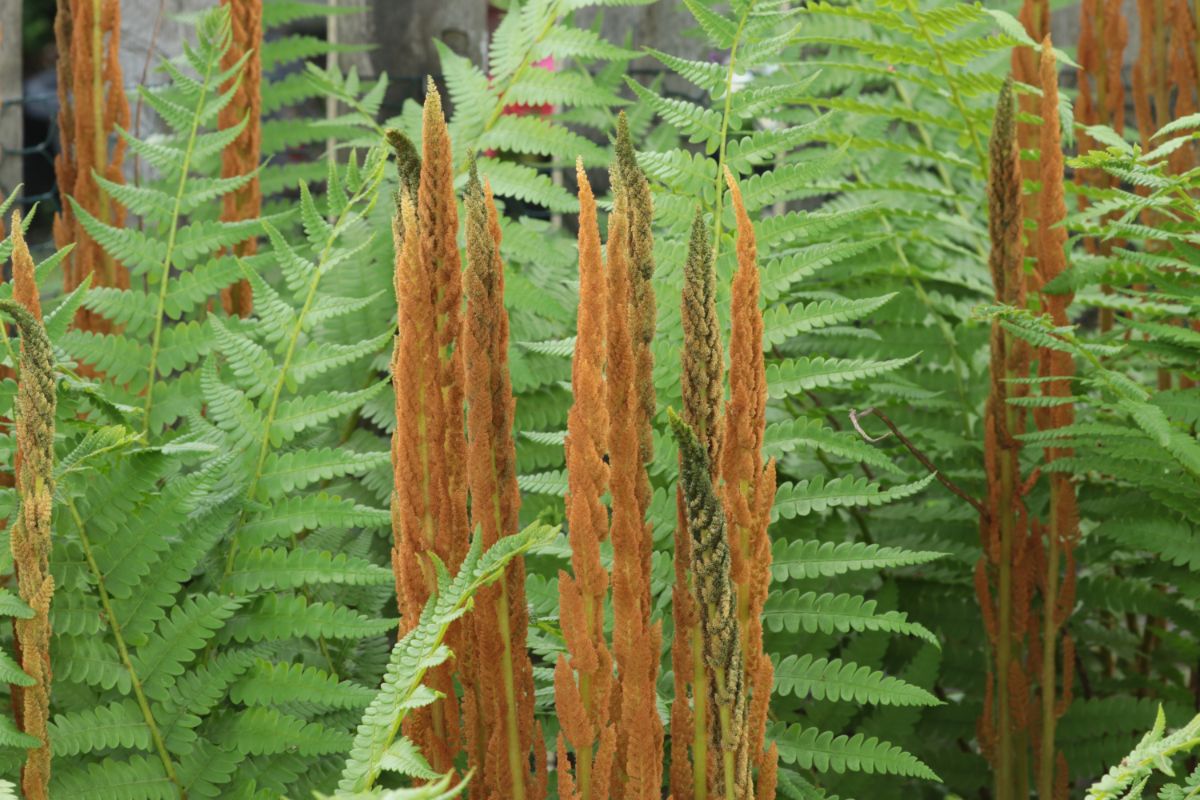
| Plant name: | Cinnamon fern |
| Light requirements: | Shade to part shade |
| Water requirements: | High |
| Growing zone: | Zones 3 to 9 |
Cinnamon ferns are native to the Americas and Asia, where they are often found growing along moist streambanks and in boggy areas. In the garden, cinnamon ferns do well in part to full shade, and they adore moisture-rich soil, so try planting them in native beds or rain gardens where water is abundant. These plants aren’t named after the spice but rather for the cinnamon-colored fronds that they produce from May to June.
Most cinnamon ferns grow to about 2 to 3’ in height, but with adequate moisture, some specimens can stretch up to 5’ tall. These plants do well with other moisture lovers, like Joe Pye weed, dead nettle, and irises. And while cinnamon ferns aren’t often sold at plant nurseries, they are much easier to track down online.
3. Lady fern (Athyrium filix-femina)
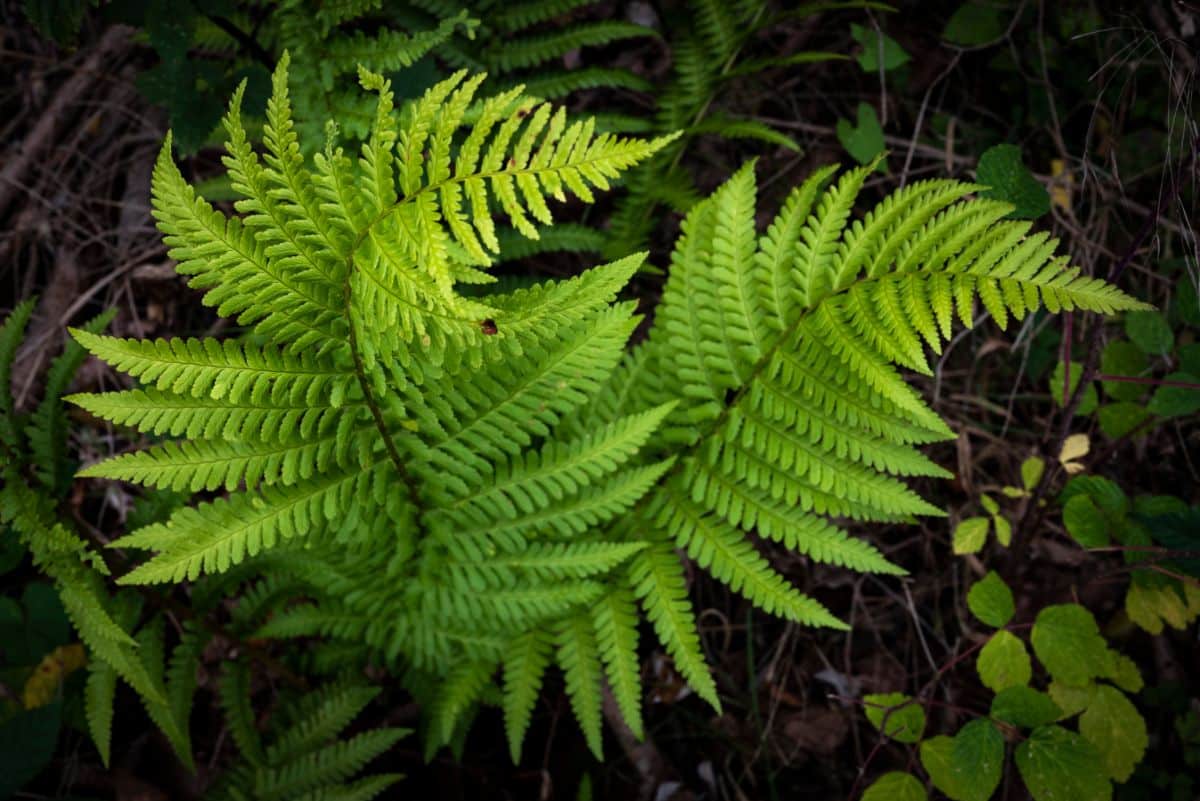
| Plant name: | Lady fern |
| Light requirements: | Shade to part shade |
| Water requirements: | High |
| Growing zone: | Zones 3 to 6 |
For that classic fern look, lady ferns are hard to beat. These elegant plants have lacy foliage and bright green coloration during summer, but their leaves turn a gorgeous yellow tone after the first frosts of fall arrive. Lady fern stalks are usually green, but you can also find plants with red or purple stalks for even more enchanting color.
When full grown, lady ferns reach about 2 to 3’ tall, and they grow roughly 2’ wide. As a smaller variety of fern, lady ferns make lovely border plants in shade gardens, but they will grow happily in other spots as long as they get plenty of moisture and they aren’t exposed to too much bright sun. A top choice for gardens with acidic-type soils, lady ferns have an impressive cold tolerance, and they will tolerate winters in areas as cool as Zone 3.
4. Sensitive fern (Onoclea sensibilis)
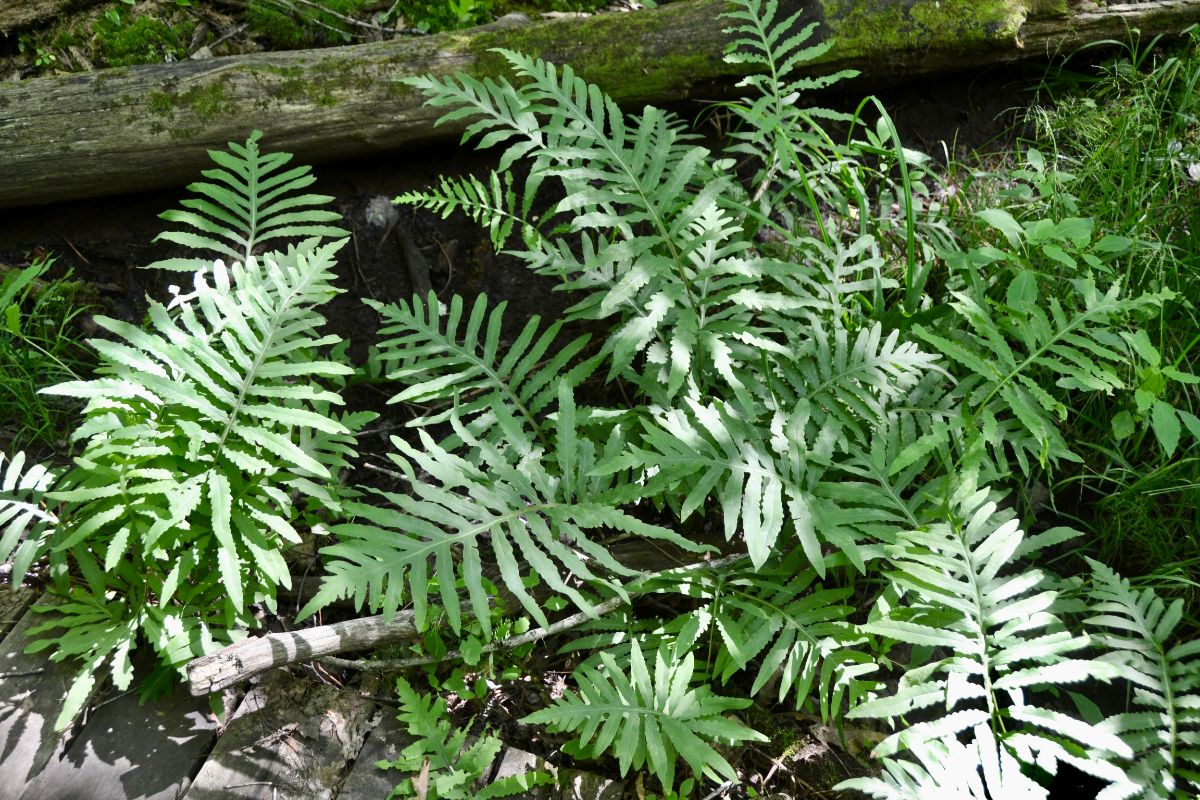
| Plant name: | Sensitive fern |
| Light requirements: | Full sun to shade |
| Water requirements: | High |
| Growing zone: | Zones 4 to 9 |
Sensitive fern is native to North America and Asia, and it’s another good choice for shade gardens, although it can also handle brighter light. When grown in sunny areas, sensitive ferns will need plenty of moisture, but they can tolerate slightly drier conditions when planted in shade. Sensitive ferns are named for their “sensitivity” to cold as these plants die back after the frosts of fall.
Growing between 1 and 3’ tall, sensitive ferns have bright green, triangular-shaped leaves, which are deeply cut with wavy edges. Not only do the leaves add lots of texture and color to garden beds, but they also complement other native plants beautifully. Try pairing sensitive ferns with other fern species or grow them near chokecherries, cranesbill geraniums, marsh marigolds or Joe Pye weed.
5. Boston fern (Nephrolepis exaltata)
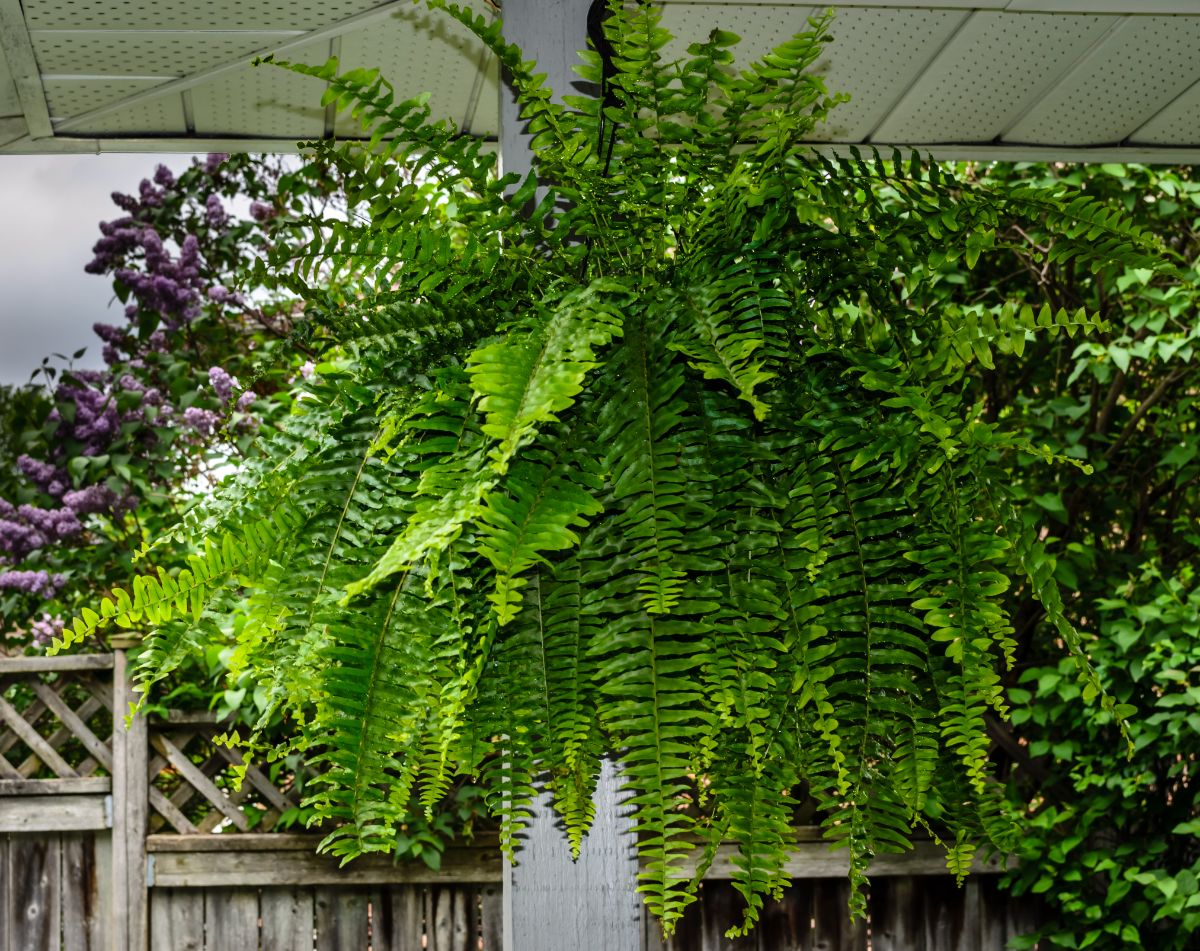
| Plant name: | Boston fern |
| Light requirements: | Part shade |
| Water requirements: | High |
| Growing zone: | Zones 9 to 11 |
Boston fern is commonly grown indoors as a houseplant, but it’s also a fantastic outdoor specimen. Often, you’ll see Boston ferns adorning porch planters, and their mounding growth habit looks lovely in hanging baskets too. These plants are not particularly cold hardy, though, and they will need to be brought indoors or grown as annuals in growing zones 8 and below.
Boston ferns can handle a light frost, but they should be protected from cold spells as well as drought, which can cause the plant’s leaves to brown and wither. If you want to keep your plants happy, amend your soil with rich, organic matter before planting, and make sure you water your Boston fern plants often. When grown in porch planters, Boston ferns often need to be watered daily in hot weather, although you can dial back your watering regimen slightly when the temperatures are cooler.
6. Australian tree fern (Sphaeropteris cooperi)
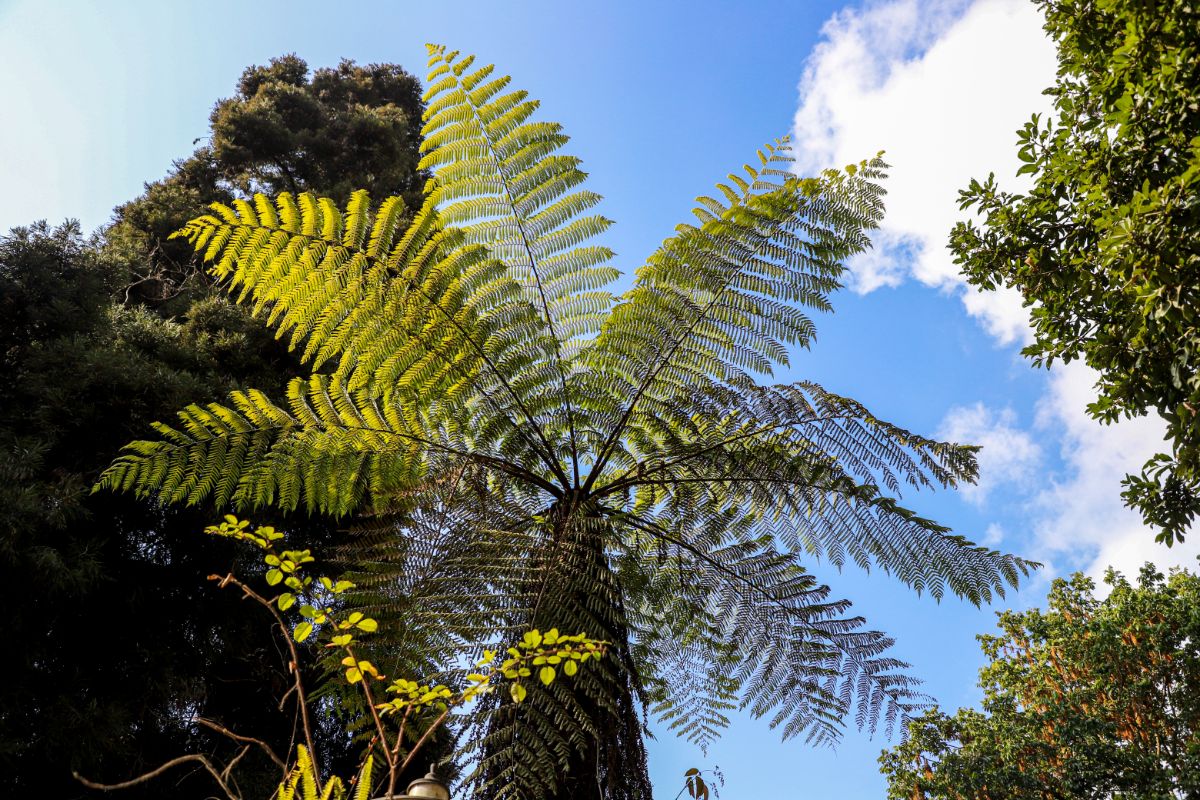
| Plant name: | Australian tree fern |
| Light requirements: | Shade to part shade |
| Water requirements: | High to moderate |
| Growing zone: | Zones 8 to 10 |
Australian tree fern isn’t like a lot of ferns you’ll find at garden centers. This massive plant can grow up to 50’ tall, and its feathery fronds can stretch over 20’ in length. Too large for indoor growing, Austrian tree fern can add a tropical touch to ornamental gardens, but it isn’t cold hardy, and it only grows perennially in zones 8 to 11.
Aside from their textured fronds, Australian tree ferns have hairy stems that stand out in mixed garden beds. These plants can be used to provide shade for lower-growing ornamentals, but be sure to locate your Australian tree ferns in partial sun to give them the boost they need to grow. If you live in a warm climate, don’t miss out on this stunning fern specimen, but remember to keep your plant well-watered to prevent leaf drop and other issues.
7. Holly fern (Cyrtomium falcatum)
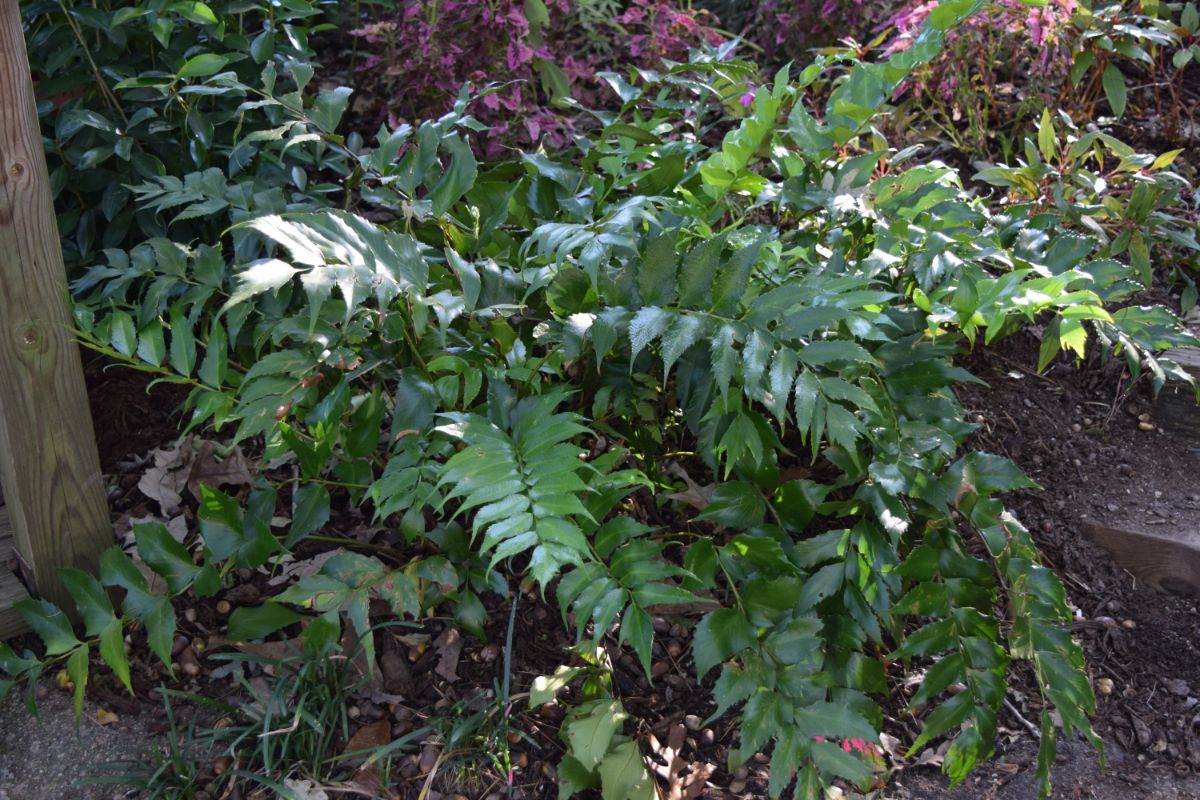
| Plant name: | Holly fern |
| Light requirements: | Shade to part shade |
| Water requirements: | High to moderate |
| Growing zone: | Zones 6 to 10 |
Named for its jagged and glossy leaves that slightly resemble the leaves of a holly bush, holly fern is an interesting cultivar that can be grown outdoors, indoors, or in a container garden. When mature, holly ferns grow about 2’ tall by 3’ wide, and their deeply saturated, green leaves are sure to draw the eye to ornamental gardens or wherever you choose to locate your plant. Often, holly ferns are used as border plants, but their dense foliage makes them fantastic, low-maintenance groundcovers too.
Compared to some fern specimens, holly ferns are relatively cold hardy, although they only grow perennially in zones 6 to 10. Plant holly ferns in full shade to part shade; it doesn’t matter, but be sure to keep your plants away from garden beds where the sun is punishingly bright. When kept outdoors, holly ferns need about 1” of water per week, but they need to be watered with greater frequency in hot weather.
8. Autumn fern (Dryopteris erythrosora)
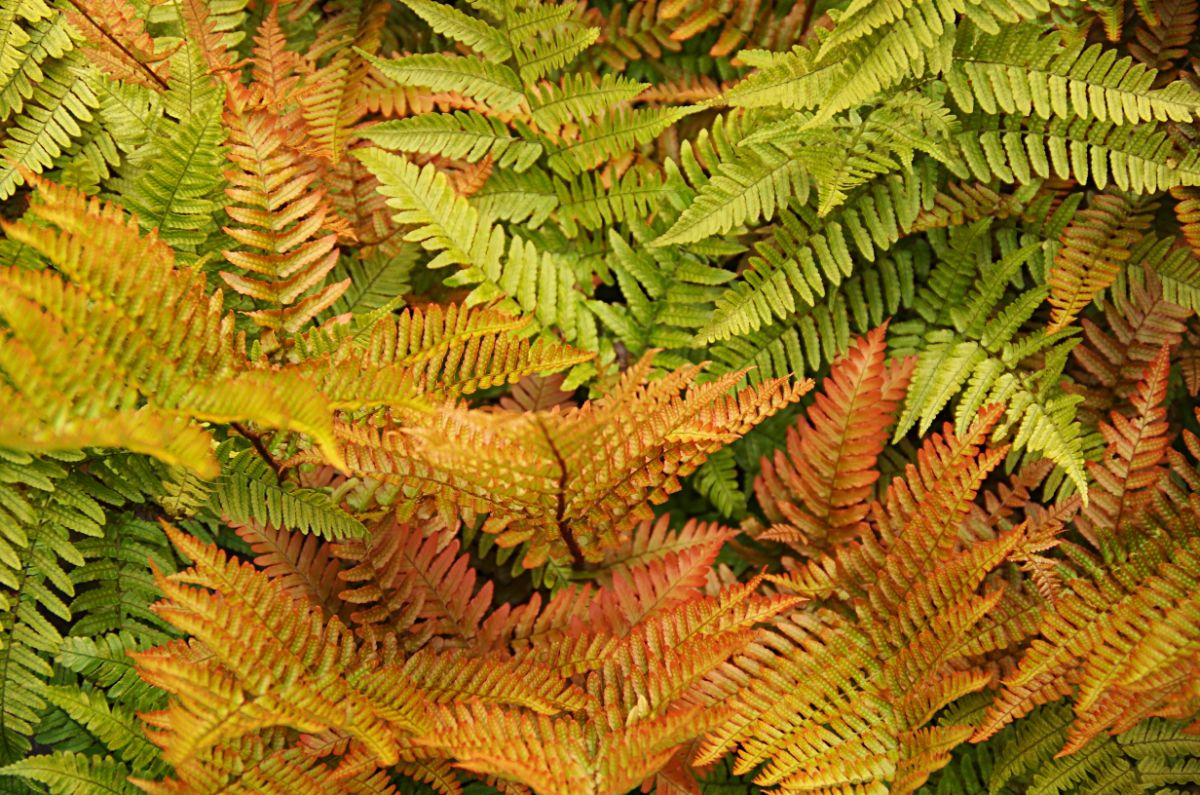
| Plant name: | Autumn fern |
| Light requirements: | Shade to part shade |
| Water requirements: | High |
| Growing zone: | Zones 5 to 9 |
Also known as the Japanese shield fern and the Japanese wood fern, autumn fern is an excellent choice for mild climates and any shade garden. Growing best in low-light beds and acidic soil, autumn ferns are undemanding plants as long as they get enough water. In regions where rainfall is abundant, autumn ferns may not need extra water, but young plants will need regular watering, and established plants should still be watered deeply when the weather is dry.
Named for its colorful foliage, autumn fern has a lot of seasonal appeal in spring as the fern fronds of this plant are a coppery color when they first unfurl. As the fronds age, they deepen into vivid green, and the entire plant maxes out at around 2’ tall. Because this is a smaller fern type, you can also grow autumn ferns indoors as houseplants, or you can pot them up in container gardens instead.
9. Maidenhair fern (Adiantum pedatum)
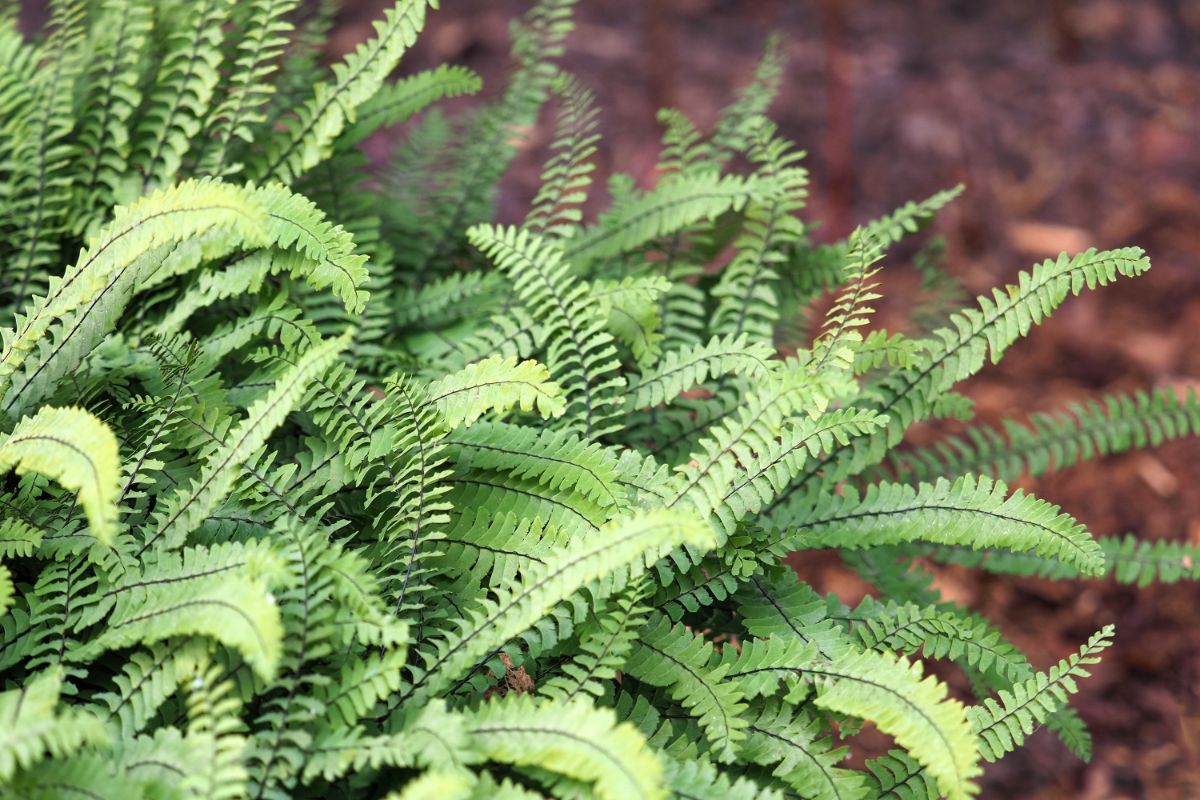
| Plant name: | Maidenhair fern |
| Light requirements: | Shade to part shade |
| Water requirements: | High |
| Growing zone: | Zones 10 to 11 |
Maidenhair fern is a popular houseplant to keep, but it craves humidity which can make it a bit of a challenge to grow indoors. But this plant can also be kept in outdoor gardens as long as you provide it with the proper balance of light and moisture. In the wild, maidenhair ferns are grown in cool, humid areas, so do your best to replicate the plant’s natural growing conditions if you want to keep your fern as happy as possible.
Since maidenhair ferns love shade and are consistently moist but not soggy, they can be grown in shady beds or near water features. Full-grown plants grow about 1 to 3’ tall, and their delicate and airy leaves can make a big impact in mixed beds or border plantings. Maidenhair ferns will thrive in soils with plenty of leaf mold and a neutral to slightly alkaline soil with a pH of between 7.0 and 8.0.
10. Christmas fern (Polystichum acrostichoides)
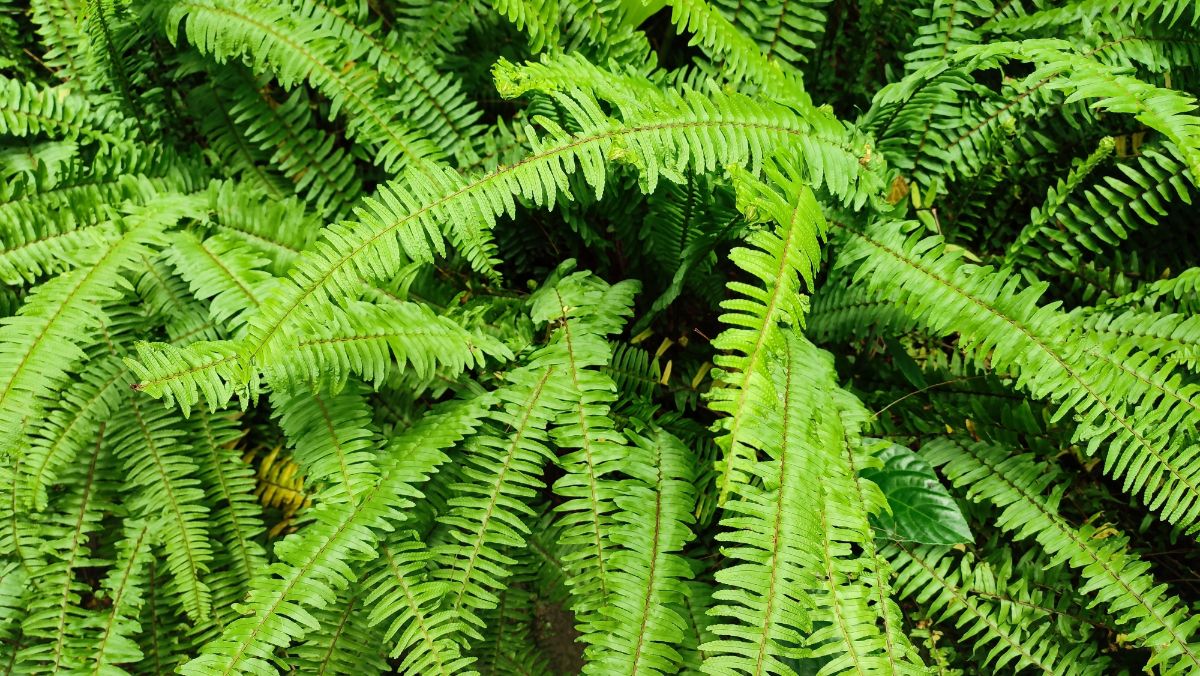
| Plant name: | Christmas fern |
| Light requirements: | Shade to part shade |
| Water requirements: | High |
| Growing zone: | Zones 3 to 9 |
Christmas ferns are an evergreen fern variety that will keep their dark green leaves throughout the winter months. Growing perennially in zones 3 to 9, Christmas fern leaves lie close to the ground in the winter months, but they still add seasonal color, and they provide a nesting site for birds and other wildlife. During warmer weather, Christmas fern fronds have a more upright silhouette, and their airy leaves stretch about 2’ tall.
Like many other fern types, Christmas ferns prefer shadier beds, and they crave acidic to neutral soil types. When Christmas fern fronds first emerge in spring, they have a bright, silvery tone that adds something unexpected to mixed beds. Try out Christmas ferns with perennial wildflowers or other low-fuss fern species, or use them as foundation plants in cottage garden designs.
11. Japanese painted fern (Athyrium niponicum)
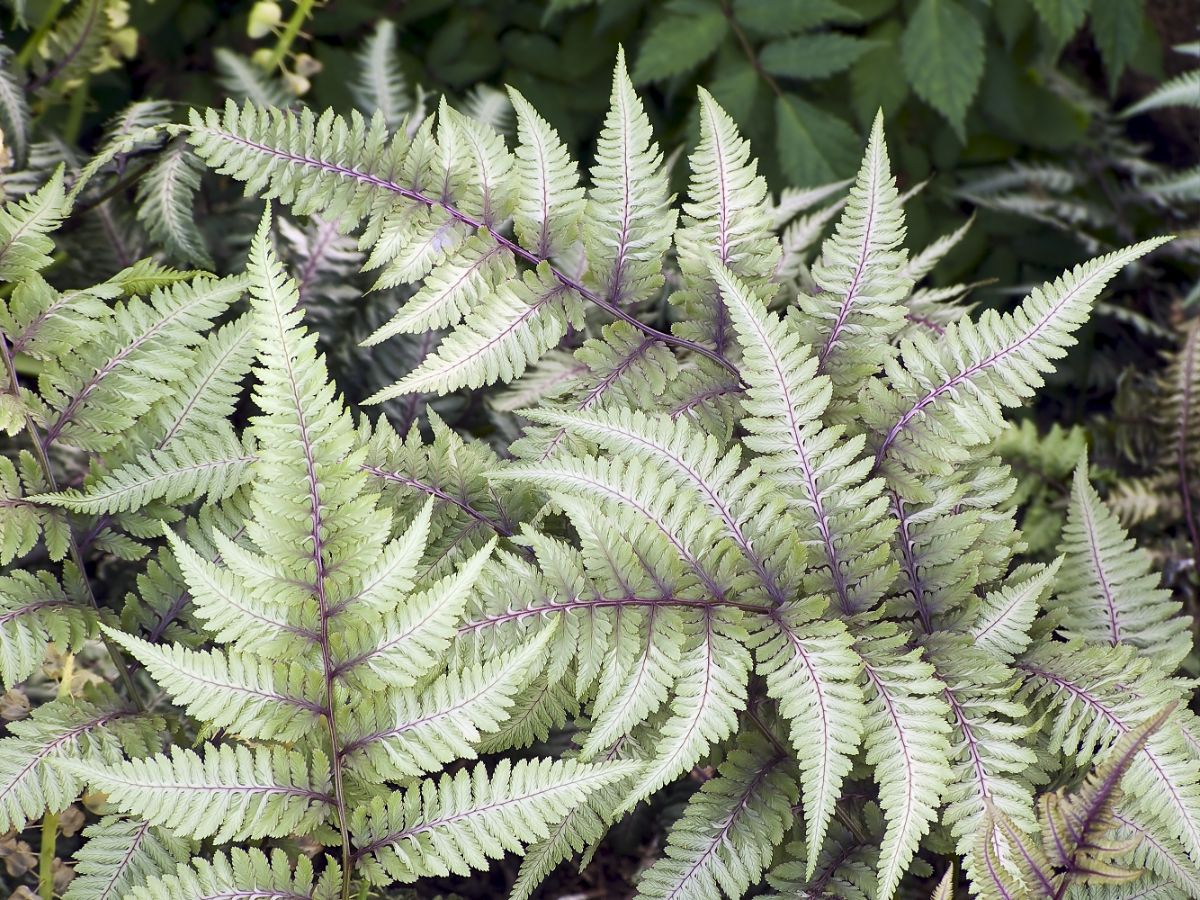
| Plant name: | Japanese painted fern |
| Light requirements: | Shade to part shade |
| Water requirements: | High |
| Growing zone: | Zones 5 to 8 |
If you’re tired of green ferns and you want something a bit different, try out a Japanese painted fern or two. These flashy ferns have variegated leaves with silvery accents and green and purple coloration. And, despite their eye-catching appearance, these plants are surprisingly easygoing, and they can be grown in zones 3 to 8.
One of the most important things to keep in mind when growing Japanese painted ferns is the amount of light these plants receive. Like many other fern species, Japanese painted ferns grow well in the shade, but they need to be protected from bright light, which can damage their sensitive leaves. Growing about 18” tall, Japanese painted ferns spread via underground rhizomes, and they can become naturalized in your garden over time.
12. Royal fern (Osmunda regalis)
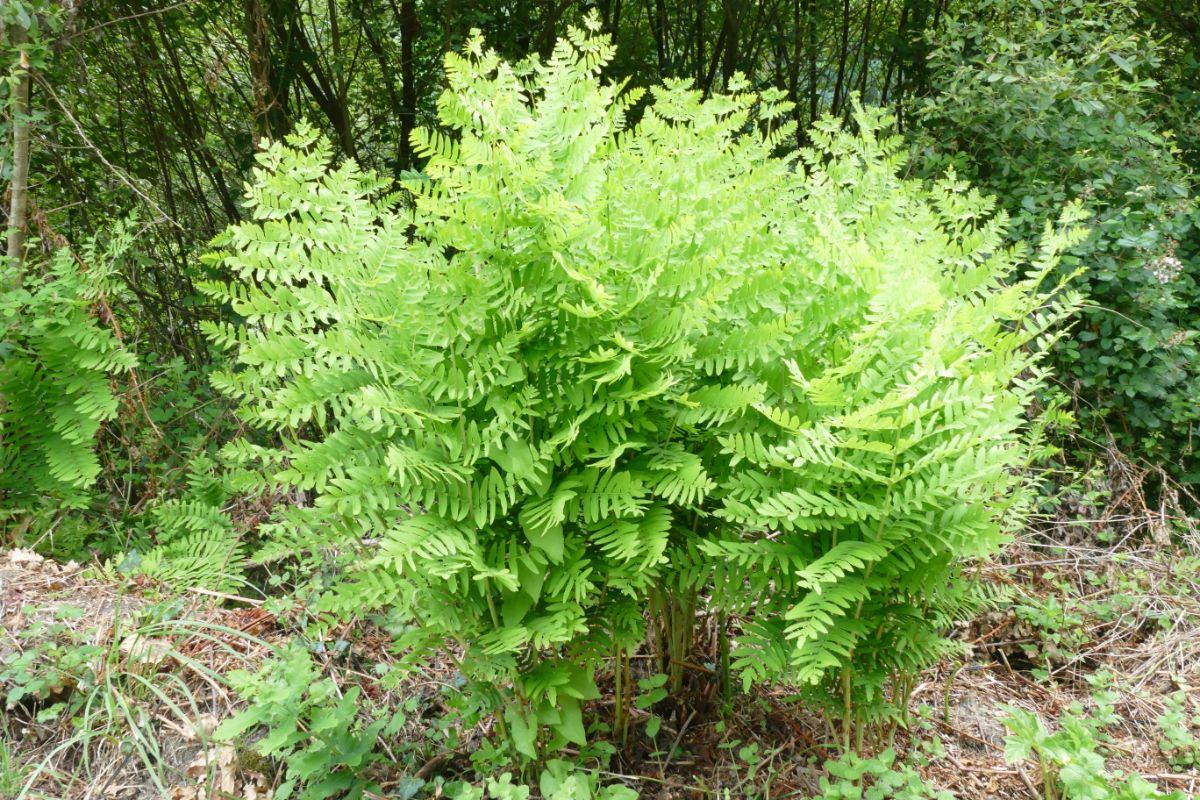
| Plant name: | Royal fern |
| Light requirements: | Shade to part shade |
| Water requirements: | High |
| Growing zone: | Zones 3 to 9 |
Also known as the flowering fern, royal ferns bring something different to the garden every season. When royal fern fronds first emerge in spring, they are a pleasant pink tone that’s quite unique. As the deeply cut leaves mature, they develop a rich green color, and the plant can also produce bronze-colored flower spikes that make a nice contrast to its shaggy leaves.
A type of Old World fern, royal ferns have an upright growth habit, and they usually grow to about 2 to 3’ tall, although plants kept in ideal conditions can grow a few feet taller. For the biggest impact, grow these clump-forming ferns together in a drift or try them out as a thriller element in potted arrangements. And don’t forget, these plants are low maintenance, and they’re resistant to deer and rabbits too!
13. Staghorn fern (Platycerium spp.)
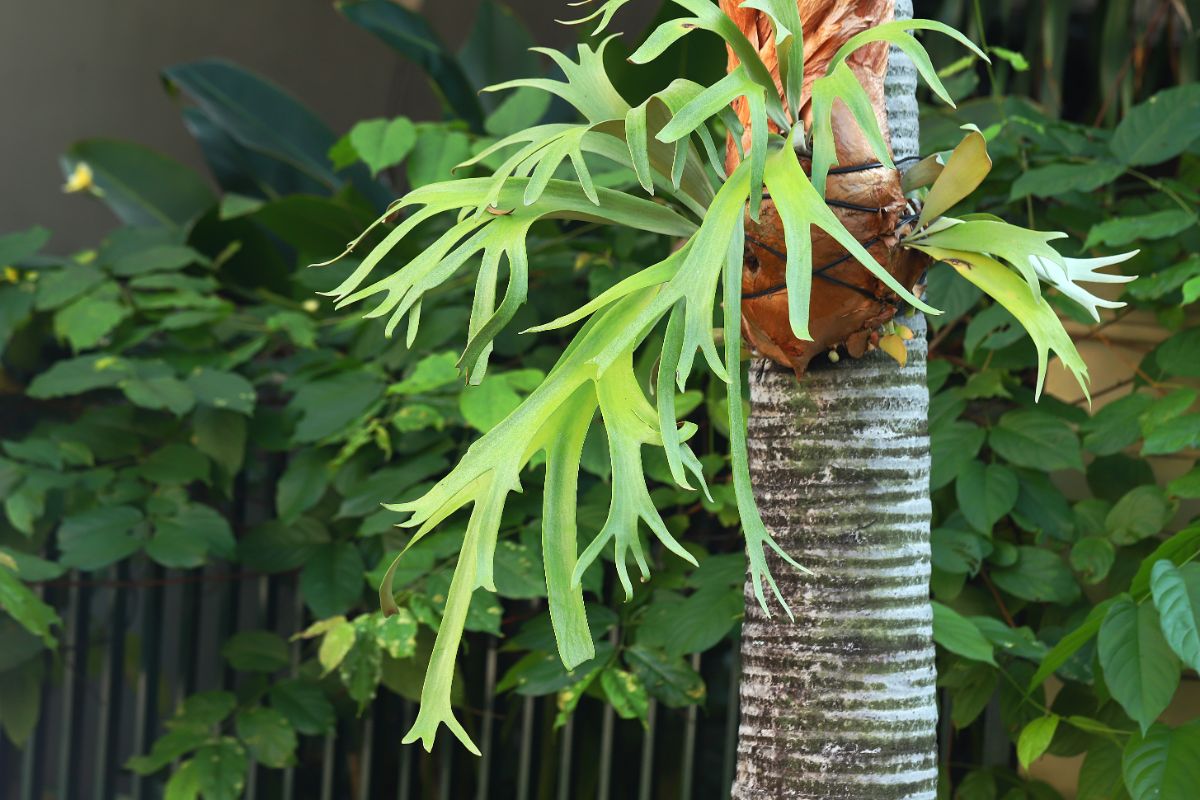
| Plant name: | Staghorn fern |
| Light requirements: | Part shade |
| Water requirements: | Moderate |
| Growing zone: | Zones 9 and up |
One of the most striking ferns around, staghorn ferns are commonly kept as houseplants, and you can often find them mounted on wooden plaques or hung in wire baskets. Also known as elkhorn ferns, staghorn ferns are native to South America, Africa, and Asia, where they grow as epiphytes on trees and rocks. If you want to keep staghorn ferns in your garden, you’ll need to mimic their natural growing conditions as closely as possible.
At times, staghorn ferns are sold potted up in containers, but this is not ideal, and it often leads to root rot. If you purchase a staghorn fern in a planter, be sure to repot it as soon as you can into a wire basket, hanging planter, or other similar arrangement. Since staghorn ferns are only hardy from zones 9 to 12, keeping your plant in a basket will make it easy to relocate your fern indoors when temperatures start to drop.
14. Sweet fern (Comptonia peregrina)
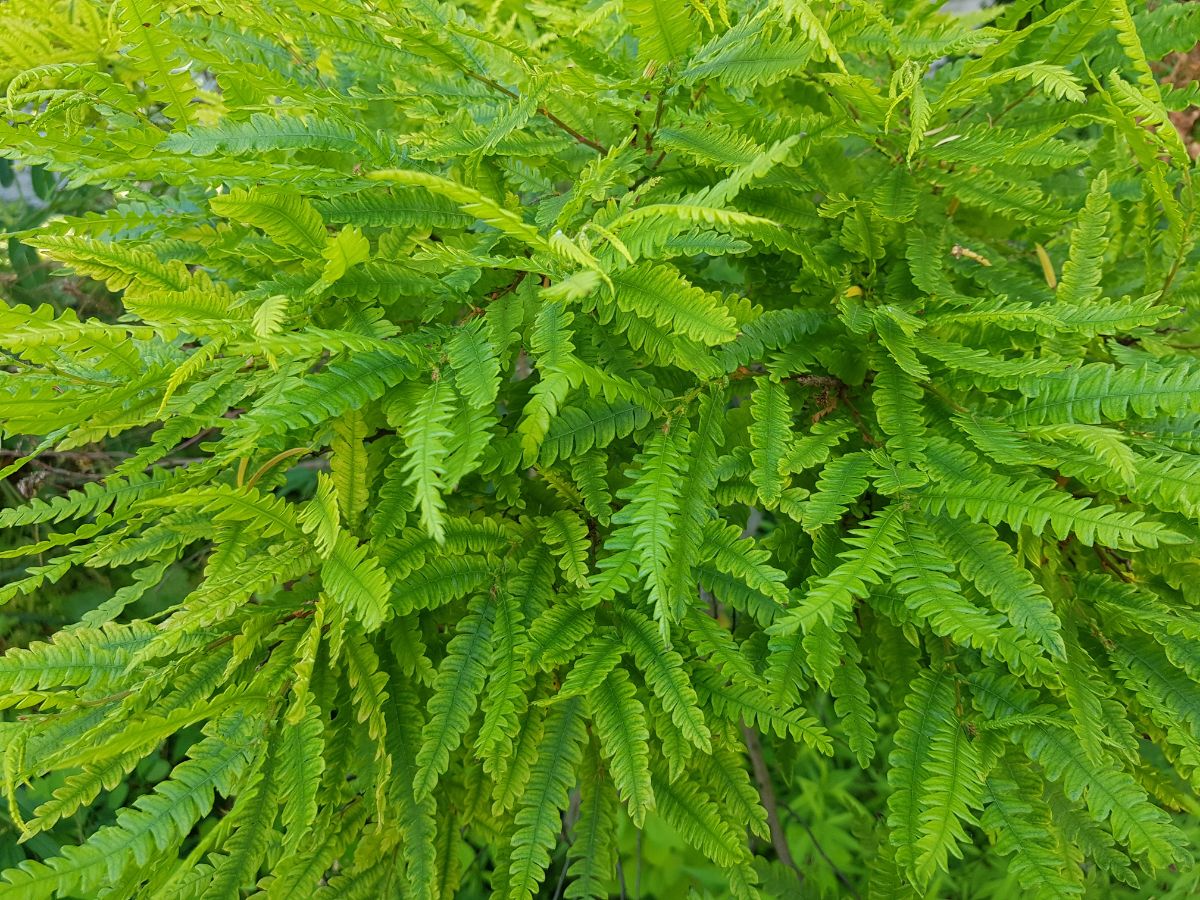
| Plant name: | Sweet fern |
| Light requirements: | Full sun to part shade |
| Water requirements: | Moderate to low |
| Growing zone: | Zones 2 to 5 |
Sweet ferns aren’t actually ferns, but they have similar attributes, and they may be a better choice than true ferns for some gardens. Sweet ferns are actually closely related to bayberry plants, and they are small, woody shrubs that can grow up to 5’ high. These plants are named for the sweet aroma of their leaves, which can be dried and used in potpourri-making and fragrance sachets.
As ultra-cold hardy plants, sweet ferns can grow in zones 2 through 5, but they struggle in hot weather, and they should not be planted in very warm climates. In spring, these plants produce small, yellow flowers, which are highly attractive to hummingbirds and other pollinators. Even better, sweet ferns can tolerate full sun to part shade, and they don’t need much water once the plants are established.
15. Asparagus fern (Asparagus setaceus)
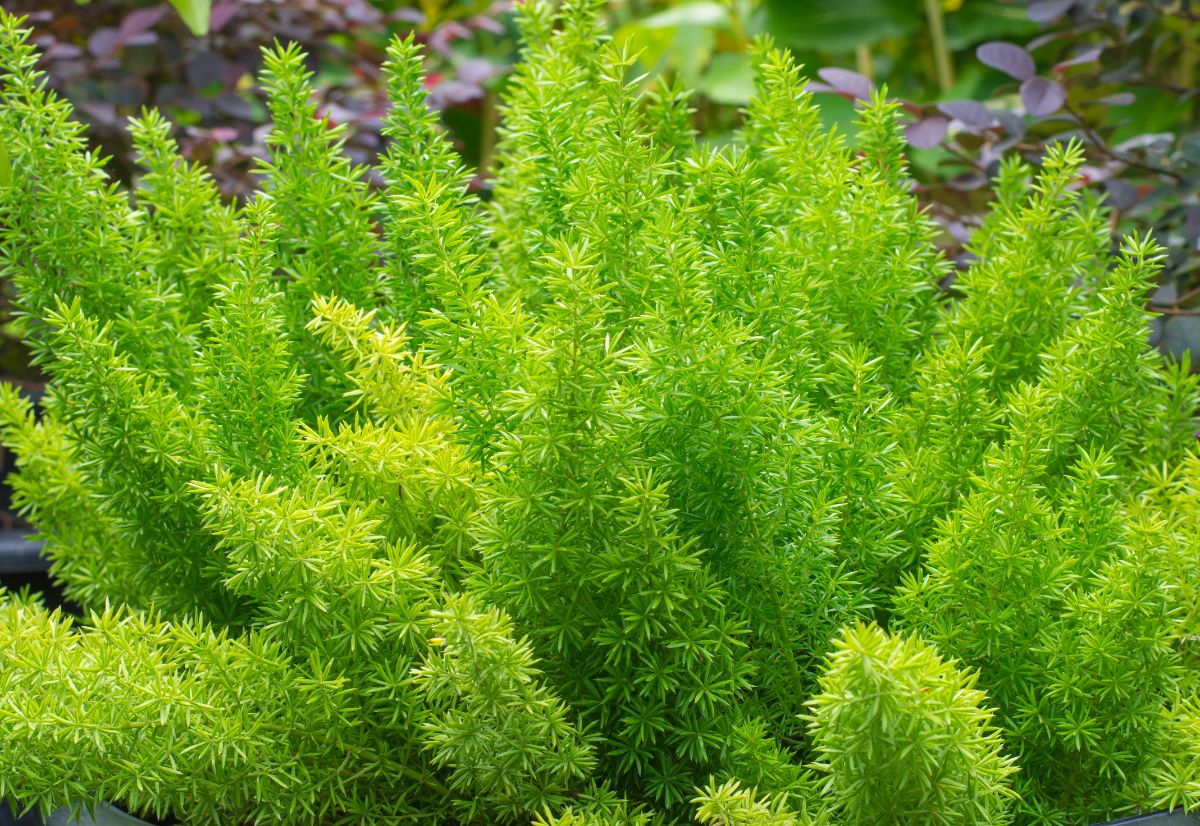
| Plant name: | Asparagus fern |
| Light requirements: | Full sun to part shade |
| Water requirements: | High to moderate |
| Growing zone: | Zones 9 to 11 |
Like sweet ferns, asparagus ferns are also not true ferns, but they have a fern-like appearance, and they can be used in place of true ferns in inground gardens or container plantings. As their name suggests, asparagus ferns are actually members of the asparagus family, and they’re closely related to lilies. As such, these plants are very toxic to cats, so be sure to keep them away from your furry friends.
Full-grown asparagus ferns grow between 1 and 3’ high, and their tightly formed yet airy leaves fit right into porch planters and hanging baskets. But, despite their soft appearance, take care when handling asparagus ferns, as their leaves conceal a thorny stem that can prickle your fingers. Unlike many true ferns, asparagus ferns can handle bright light with ease, and they also have relatively low watering needs.
Frequently asked questions
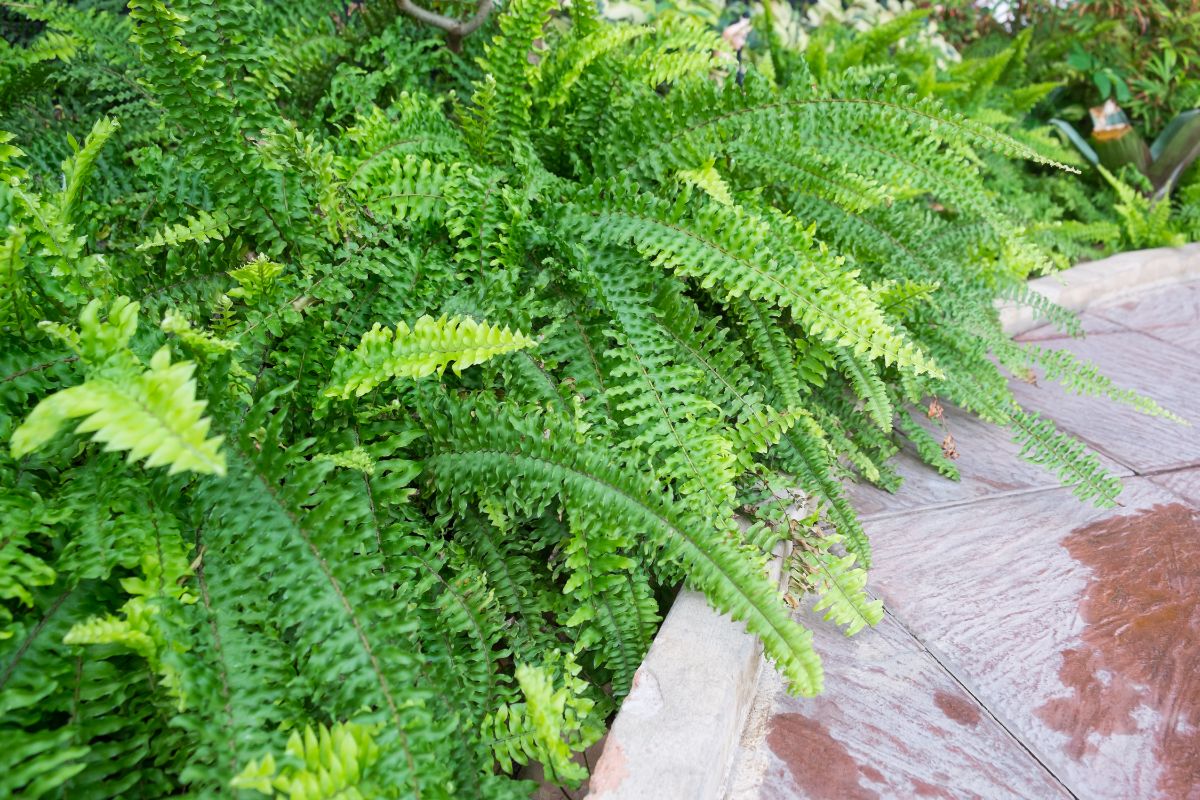
Ferns have different growing requirements, and not all ferns need to be cut down to the ground in winter. However, most deciduous ferns will look tidier if you cut the fronds back late in the season after frost begins to kill the leaves. Using sharp pruners or gardening shears, gather the fronds in one hand and cut them down low to the ground in late winter, but be careful not to damage any new leafy growth.
Cold hardy ferns can be left outside all winter long, but warm weather-loving species will need extra protection during the winter months. Some fern varieties, like Boston ferns and maidenhair ferns, can’t survive outdoors in winter in most areas, but they can be kept indoors during the cooler months and then returned to the outside in spring. If you do keep ferns indoors in winter, be sure to place them near a humidifier or on a pebble tray to keep their leaves from turning brown and crispy in the dry, indoor air.
Most ferns grow best in full to part shade, although there are a few fern species that can tolerate higher light levels. Sensitive ferns, for instance, can grow in the sun as long as they are provided with lots of water. Fern-like plants, like sweet ferns and asparagus ferns, are also able to grow in sunny gardens where most ferns won’t thrive.
The quickest way to get more fern plants to spread around your garden is to divide clumps of existing ferns in spring. To do this, water your ferns well to loosen the soil and then gently dig the ferns up with a shovel or gardening fork. Cut or pry the clump apart into smaller pieces, ensuring that each fern section has a few stems and roots, and then plant your new ferns in your garden beds.
Ferns are relatively light feeders, and they won’t need much fertilizer, especially if you enrich their soil with compost prior to planting. Throughout the growing season, you can also fertilize your plants with a standard, balanced, organic fertilizer to support their growth and help ferns produce new, lush fronds.
Small fern plants, especially heat-loving species, are top choices for hanging baskets. Some of the best ferns to grow in hanging pots include Boston ferns, maidenhair ferns, and staghorn ferns.
Summary
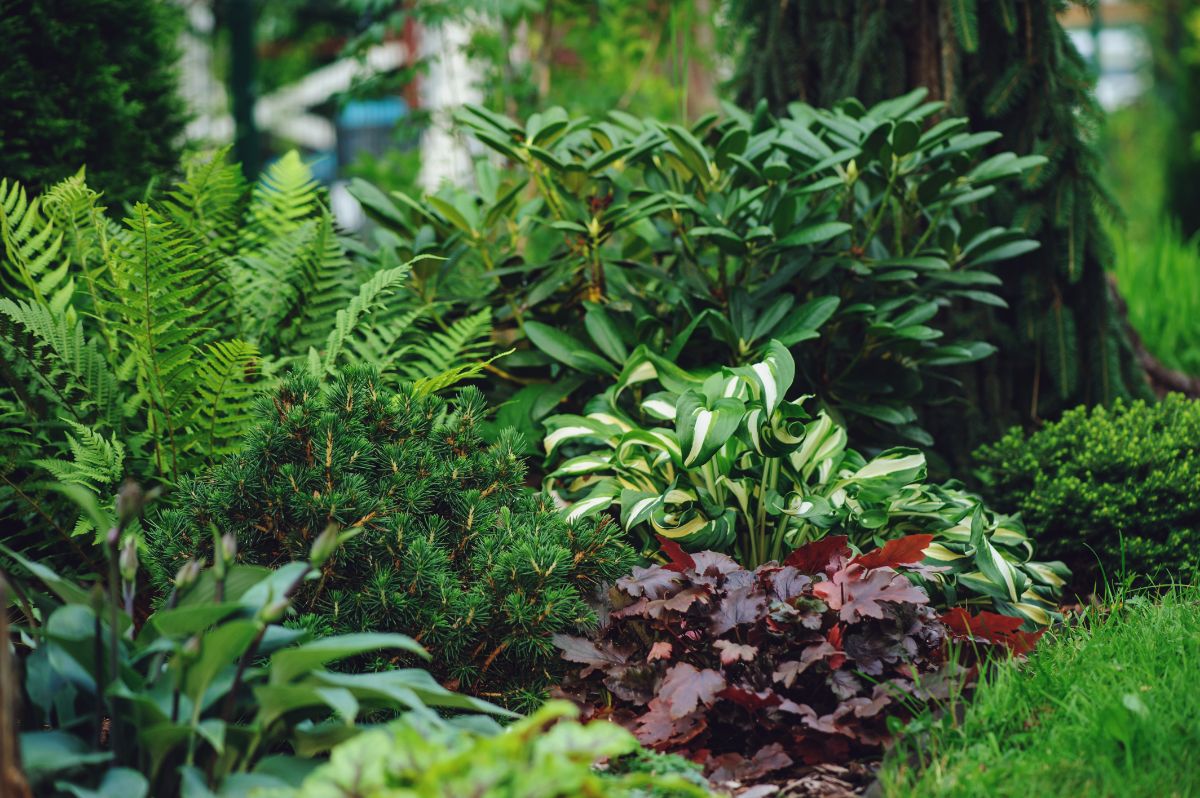
Whether you have a small or large yard, ferns are relatively easy plants to keep, and they can reward you with rich green leaves and lots of texture throughout the growing season. Not all gardens are suitable for ferns, but if you have a shady space or acidic soil, ferns are some of the best plants to grow. However, even if you have a sunny yard, there are a few striking fern varieties that will work, and they’ll give you all the lush leaves and pleasing lines of shade-loving ferns!
While ferns look impressive on their own, you can take your shade garden to the next level by pairing ferns with some of these other shade-loving plants. Grown in a mixed garden, ferns are some of the most alluring border or backdrop plants you can find, but they’ll also work well in container gardens or planted in soggy spots along with these other moisture-tolerant plants. No matter how you use ferns in your landscaping, ferns are sure to delight your senses from spring through fall!

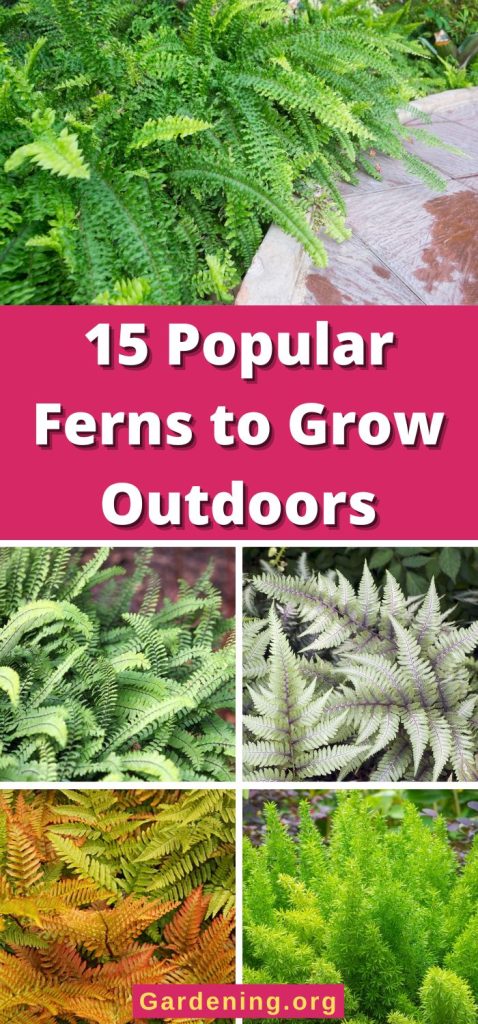

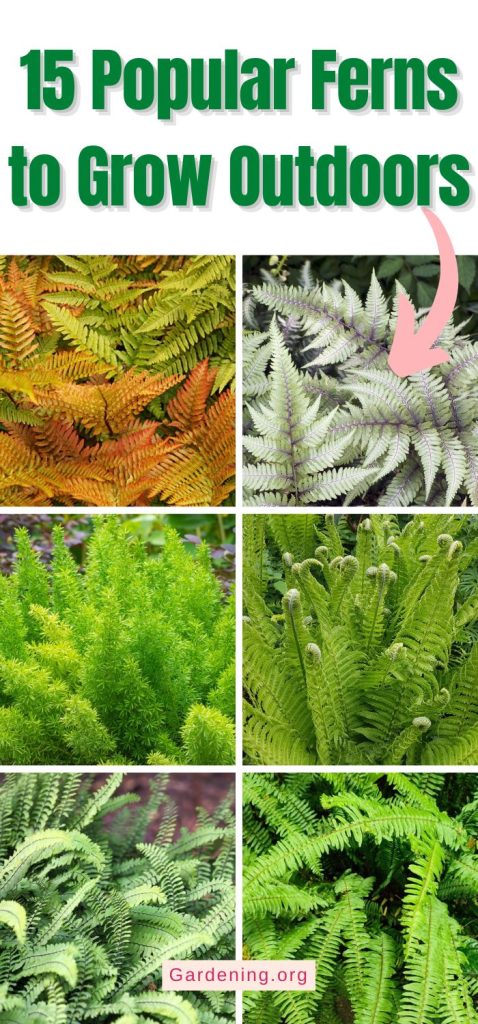

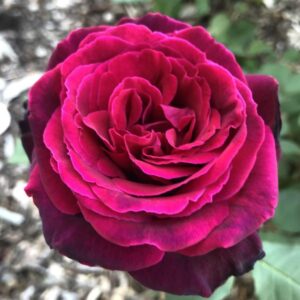
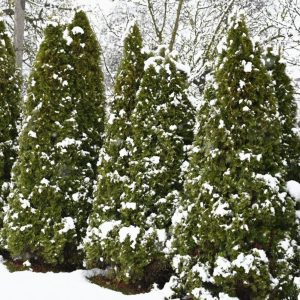


Leave a Reply